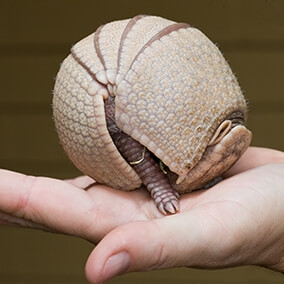
Three-banded armadillos are various shades of brown. The hard carapace covering their bodies develops from the skin and is composed of strong, bony plates, called scutes. The tail, top of head and the outer surfaces of the limbs are also usually armored.
When frightened, they will roll up almost all the way until their armor forms a trap that snaps closed on their predator’s hand or paw. The shell also helps protect them from the thorny vegetation that armadillos frequently pass through. The under surface is soft, hairy skin. The carapace is not attached to the skin on the two sides, allowing the head, legs and tail to tuck inside when the animal rolls into a ball. This works well against most predators, but unfortunately has made La Plata three-banded armadillos easy prey to human hunters.
The range of La Plata three-banded armadillos includes parts of Bolivia, Brazil, Paraguay and Argentina. They live in open, grassy areas, open forests and marshes. They do not dig burrows like most armadillos, but use the abandoned burrows of anteaters when they can get them.
They use their well-developed sense of hearing and smell to detect both predators and prey. In the wild they feed primarily on ants and termites, which they obtain using their powerful forelegs and claws.
At the Smithsonian’s National Zoo, La Plata three-banded armadillos are fed soaked insectivore diet and mealworms.
Credit : National Zoo
Picture Credit : Google




